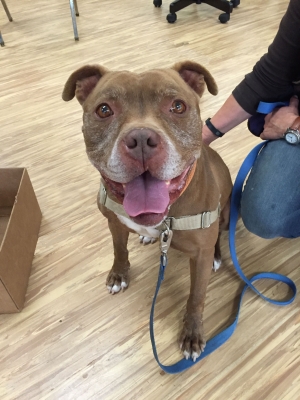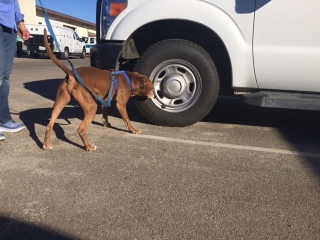K9 Nose Work® for Shelter Dogs - Enrichment for Both Ends of the Leash


K9 Nose Work® for Shelter Dogs – Enrichment for Both Ends of the Leash
by Genie Tuttle, CPDT-KA, CNWI
The thought of visiting an animal shelter, much less regularly volunteering at one is daunting for many animal lovers, especially those of us who sense the animals’ pleas to find a new home as we walk past kennel after kennel of ever hopeful eyes. Up until recently, I was that person during visits to my local shelter, walking around in tears wearing dark sunglasses, while avoiding eye contact with other “two-leggeds”. It felt so overwhelming and hopeless.
Times have changed! The animal shelter near me, Ventura County Animal Services (VCAS) is the largest no-kill open-admission municipal shelter in the state of California, regularly housing and caring for nearly 250 dogs and more than 150 cats plus many other homeless animals. VCAS recently had its second anniversary of going “No Kill,” a transformation which requires a large amount of support, and last year I decided to join the team. Each week I work with volunteers, staff and specially selected dogs teaching nose work as an enrichment tool for long-term dogs, reactive dogs who can’t participate in play groups or other enrichment activities, older dogs and dogs with special needs. The sport of K9 Nose Work® welcomes all.
As a member of the National Association of Canine Scent Work, LLC® or NACSW™, I had the privilege of learning from experts how best to implement a shelter-dog Nose Work program and help shelter dogs not only cope, but thrive in their shelter environment until it’s their turn to go home. It’s by far one of the best things I’ve ever done!
There are some interesting differences working on nose work with shelter dogs as opposed to companion dogs (dogs with homes/families). The shelter dogs I’ve worked with take to the sport with an intense degree of focus on the task at hand once they overcome any fear of being inside the room we use for the activity. Conversely, dogs who live in a home environment with families constantly “check in” with their owners for guidance or permission, standing still or sitting and staring at their owner for direction in the early stages of learning nose work. Eventually they catch on to the way the game is played, after a bit of a paradigm shift from expecting help solving the puzzle to working independently and solving it on their own.
A possible reason for this is that dogs who live in homes have had many opportunities to learn from people how to fit into the human world, e.g. obedience, house manners, agility, etc. In order to be a successful companion dog, you need to follow the rules and fit in while possibly suppressing certain powerful natural instincts day after day. Domestic dogs are extremely good at this when given the opportunity to form relationships with people, but many have fewer opportunities to employ their special canine sensory skills, like scent work. Shelter dogs are not nearly as emotionally bonded to the volunteer handlers, so more readily rely on their own natural skills to problem solve. This puzzle solving concentration is enrichment at its best.
One of the powerful and enriching concepts of K9 Nose Work® is that we do not place any emphasis on obedience cues or other human constructs, but rather we attempt to get into the dog’s world and learn from them about their impressive olfactory capabilities and how odor and scent work for them. Part of the fun for the human side of the equation is honing our observation skills together, watching the dogs work as independently as possible, and looking for changes in behavior as they work out the scent puzzle. Not giving dogs “orders” or direction and just following them as they work is a very different mindset for people and companion dogs alike. Different and POWERFUL. Honestly, it’s addicting to watch.
The first day I conducted nose work training at the shelter there were several volunteers gathered to watch, and one of them said, “You’ve gotta try Cowboy, he’s so A.D.D., he’ll never be able to do that.” I was instantly excited to work with him, because nose work can benefit a dog like that tremendously! A common misconception is that nose work is an elevated level of training to be done once dogs have accomplished other skills. Not true, some of the best nose work dogs are wild untrained puppies because they have no “rule book” to follow. Cowboy is a middle aged “pit bull type” dog, and that day he burst into the classroom pulling and panting and true to form, hopped up on the counter by the window and tried to climb the blinds. Fantastic! His drive and enthusiasm would serve him well in this sport. Since then, he has become the poster child for the power of nose work to positively unlock a dog’s focus and drive, and is by far the most accomplished nose work dog at the shelter, progressing to the target odor of birch and outdoor vehicle searches. After two short classes he was able to enter the room or the search area, get right to work, tail wagging, keenly “on the job,” happy, focused and engaged. Staff and volunteers are very proud of him and really enjoy watching him and the other dogs participate in nose work. Fingers crossed for Cowboy that he finds a forever home soon.
While canine enrichment is our number one goal, our additional hope is to show potential adopters that you can’t judge a book by its cover—there is so much more to all of these dogs than meets the eye and oftentimes the stereotype. Appearance simply tells you nothing about a dog’s actual talents.
If you’ve ever questioned your ability to add value to a “seemingly” hopeless situation, I encourage you to take the plunge. Bring your skills to the table whatever they may be, and become part of the solution. There are so many great people working together to make a positive difference in the lives of shelter pets, join them and you’ll never be more enriched.




